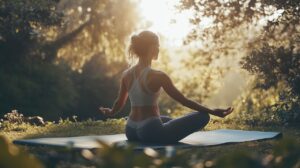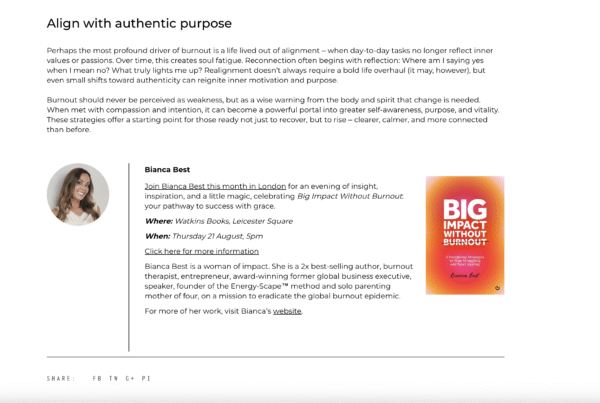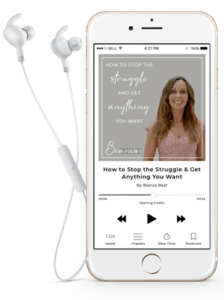The Forgotten Rhythm Beneath Modern Success
We live in a culture addicted to acceleration. There’s a warped pride in our ‘Age of Acceleration’ in fact (just ask Thomas Friedman…). Coffee-fuelled mornings blur into high-intensity workouts, long working hours, and late-night emails. Productivity is celebrated, whilst peace is too often neglected. Yet all living systems, from our heartbeat to the tides, operate on one simple truth: rhythm.
In bioenergetic science, this natural rhythm is described as The Life Pulse. I capitalise here as this Life Pulse is worthy of reverence and is absolutely key to soothing this relentless accelerating we’re all obsessed with. The Life Pulse is the continual cycle of expansion, contraction, and stillness that sustains vitality. And when we, as in Nature, honour this rhythm, our energy stabilises, creativity flourishes, and success becomes sustainable rather than exhausting.
Understanding the Life Pulse
Biologically and energetically, human beings are rhythmic organisms. Every cell pulses, every breath alternates between inhale and exhale, every day oscillates between wakefulness and sleep.
This pulse follows three repeating phases:
Expansion — outward energy, creativity, action, expression.
Contraction — inward energy, integration, recovery, reflection.
Stasis — stillness, the pause where regeneration occurs before a new cycle begins.
Modern life, however, rewards only expansion. We caffeinate, accelerate, and overcommit, rarely allowing true contraction or stillness. This constant outward push distorts the natural life pulse. The result? Burnout, anxiety, disrupted sleep, and chronic fatigue — the hallmarks of a world that’s forgotten how to rest. Certainly the hallmarks of my yesteryear when productivity and the badge of busy were my crushing guideposts.
The Science of Rhythmic Productivity
As I have learned, lived and now teach, true high performance doesn’t come from perpetual output, but from mastering the oscillation between doing and being. Embracing the excitement and creativity that surges during expansion, honouring the gentle contraction that inevitably follows, and settling comfortably within the void of stillness that stasis brings (despite the unfamiliarity and ensuing resistance). Tuning into The Life Pulse has ironically become a skill we need to master as modern culture has pushed us so very far from our innate cadence. Abundant research from Harvard et al and beyond shows that strategic recovery — deliberate pauses between periods of effort — enhances long-term productivity, creativity, and decision-making. The human system was never designed for constant activation. And so we need to learn how to listen the signals our body is constantly alerting us to; how to flow harmoniously with our Life Pulse (again, we did this unconsciously as babies remember).
 Caffeine: When Artificial Expansion Hijacks the Pulse
Caffeine: When Artificial Expansion Hijacks the Pulse
Caffeine is a remarkable tool when used wisely. It sharpens focus, heightens alertness, and can enhance performance. Yet biochemically, it achieves this by blocking adenosine — the molecule that signals fatigue. In other words, caffeine silences the body’s natural call for contraction.
A 2021 Nature Neuroscience study revealed that consuming caffeine within six hours of sleep reduces deep, slow-wave rest by up to 20 percent. So, even if you fall asleep, the quality of that sleep suffers, disrupting hormone regulation, memory consolidation, and tissue repair. Over time, this pattern locks the body into a false state of expansion — energised on the surface but depleted beneath.
To work with rather than against your rhythm, delay your first coffee for 90 minutes after waking. This aligns with your body’s natural cortisol peak, preventing overstimulation. Avoid caffeine after 2 p.m. and instead hydrate, move, or step outside for natural light — cues that restore the circadian balance. See my blog, Is Caffeine As Dangerous as Cocaine for a deeper dissection here.
Exercise: Movement as Conscious Expansion
Movement is an essential part of The Life Pulse. Exercise stimulates circulation, oxygenation, and emotional release — a healthy expression of expansion. It is, in essence, an energetic exhale.
However, just as over-breathing leads to hyperventilation, overtraining or using exercise as a stress outlet without recovery leads to burnout. Studies from the Journal of Sports Medicine demonstrate that overtraining elevates cortisol, suppresses immunity, and impairs sleep — identical effects to chronic psychological stress. Exercise should amplify vitality, not drain it.
For leaders, parents, and entrepreneurs juggling multiple demands, take heed when architecting an exercise regime. Perhaps softness over discipline is more important. Become sensitive to what your body needs per weekly, monthly and daily flow, and tune into your natural holistic states of expansion and contraction intuiting what you need emotionally and mentally as well as physically. Morning exercise aligns best with the body’s natural expansion phase as early movement boosts dopamine and endorphins, enhancing focus and confidence. Yet the opposite phase — contraction — is equally critical. So, gentle stretching, yoga, or restorative walks in the evening help shift the nervous system back into parasympathetic dominance, the physiological state of calm and regeneration. Think of your day as a wave: expand in the morning, integrate at midday, soften into rest at night. Sometimes, I need day after day of contraction and that’s okay. At other times, I can’t wait to run the moment I open my eyes. Other times, I want to walk not run. I tune in.
Sleep: The Sacred Art of Contraction
Sleep is not the opposite of productivity; it is its foundation. During deep sleep, the brain’s glymphatic system clears toxins, cells repair, and emotional experiences integrate into long-term memory. This is the contraction phase in full expression — inward, silent, essential.
The World Health Organization estimates that one in three adults globally do not get adequate sleep. Insufficient rest impairs decision-making, emotional regulation, and creative thinking — all vital capacities for high-performing leaders and parents. Neuroscientist Matthew Walker’s research shows that individuals sleeping fewer than six hours per night have a 20–30% reduction in cognitive performance compared to those with seven to eight hours.
From a bioenergetic perspective, sleep is when the body recalibrates its electromagnetic field. The brain’s electrical rhythms slow, and the heart rate synchronises with breath, creating coherence across the system. In this phase, the life pulse resets. Make going to bed the start of your new day and worship it! My bedroom is a sanctuary and bedtime holy.
Stress: When the Rhythm Freezes
Stress is the biological signal for expansion — it mobilises energy for survival. In short bursts, it’s vital and adaptive. But when stress becomes chronic, the system forgets how to contract. The sympathetic nervous system (fight-or-flight) stays switched on, flooding the body with cortisol and adrenaline. Digestion, immunity, and emotional regulation all shut down.
Study after study, Stamford most recently, proves that chronic stress shrinks the prefrontal cortex — the part of the brain responsible for executive function and creativity — while enlarging the amygdala, which governs fear and reactivity. In energy terms, this represents a field that’s overcharged but incoherent — bright but chaotic.
Restoring balance requires deliberate practices that trigger the parasympathetic response. Slow breathing (in for five seconds, out for five) signals safety to the nervous system. Mindfulness, yoga, or simply spending time in nature can reduce cortisol by up to 30% within weeks. Stress isn’t defeated by doing less, but by oscillating more consciously — engaging fully, then recovering deeply.
Stasis: The Still Point of Integration
Between each expansion and contraction lies stasis — a brief still point where the system integrates before moving again. Physiologically, this corresponds to the space between breaths, heartbeats, or neural firing patterns. It is the zero-point of the life pulse, where energy reorganises and insight emerges. Studies from the University of Wisconsin–Madison show that even ten minutes of mindfulness a day can enhance cognitive flexibility and emotional regulation by strengthening neural networks associated with attention and compassion. In leadership terms, stillness improves clarity and decision quality. It is the quiet from which creative solutions arise.
Living the Life Pulse: Practical Integration
For busy bees, be you parents, entrepreneurs, leaders and all, integrating this rhythm into daily life is a radical act of grace. It’s about trading constant activation for intelligent oscillation — moving between effort and ease with awareness.
Practical ways to honour Your Life Pulse:
-
Map your rhythm. Notice when your energy naturally rises and falls. Schedule creative or demanding work during expansion, and quieter tasks or reflection during contraction.
-
Use caffeine wisely. Treat it as a strategic enhancer, not a substitute for rest.
-
Exercise with intention. Match physical exertion to your available energy, and follow intensity with recovery.
-
Prioritise rest. Sleep, stillness, and silence are non-negotiable components of sustainable performance.
-
Build pauses into your day. Between meetings, after a task, before sleep — take two minutes to breathe and reset your nervous system. Beyond the day, plan for recovery time across the weeks, months and years. Remember the Power in the Pause – not a cliche but a reality. Inspiration flows when we step out of the doing and gracefully enter being.
Success with Rhythm, Not Resistance
Sustaining healthy success isn’t about doing more; it’s about moving in rhythm with this beautiful, vibrant, ever-guiding pulse. Your Life Pulse is your energetic start point. Graceful productivity arises when expansion, contraction, and stillness are honoured equally — when energy is directed, not depleted. To live and lead with grace is to understand that you are not a machine designed for endless output but a living system governed by pulse and flow. When you honour that natural oscillation — through conscious use of caffeine, mindful exercise, restorative sleep, and balanced stress — your productivity becomes a reflection of harmony rather than hustle. This is how you achieve success that feels not only powerful but peaceful. This is success with grace.
















